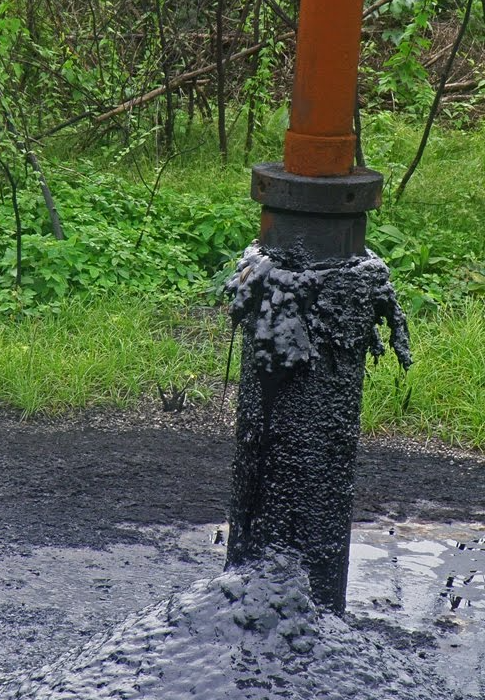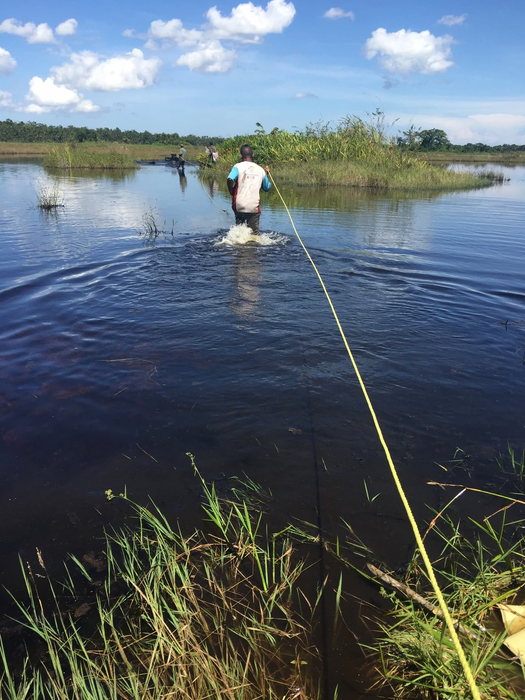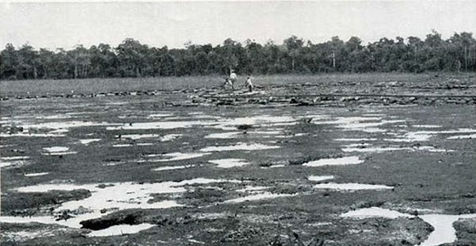

The Guanoco project is an environmental development plan led by Terquimca that encompasses the entirety of the Guanoco region, including the asphalt lake. The project's goal is to use the region's natural resources to protect the environment and promote the socioeconomic development of the Warao Tribe, an ancestral indigenous community in Venezuela that has been granted autonomy and sovereignty over the Guanoco fields and lake as part of their ancestral territory.
In other words, The Guanoco Project is a comprehensive plan to revitalize the Guanoco region and promote the sustainable development of the Warao community.
"We are committed to preserving the environment and promoting indigenous development."

Strategic alliance between Terquimca and the Warao community
Guanoco Project

Lake Guanoco Data

Geography
Lake Guanoco is a large asphalt lake located in the southeastern sector of Sucre State, Benítez Municipality, Venezuela. It is 65 km northeast of the city of Maturín, Monagas State, and about 140 km southeast of Cumaná. It is also about 25 km east of the Gulf of Paria.
%205_05_12%20p_m_.png)
Surface & Depth
The asphalt lake has an area of 420 hectares (4.2 square kilometers) and a depth of 1.5 to 2 meters. Because the asphalt originates from the subsoil, it is assumed that the lake is much deeper than described.

Estimated Reserves
The Guanoco field has oil reserves of 662 million barrels and asphalt reserves of 75 million tons, making it the largest asphalt lake in the world. PDVSA has exploratory projects underway to quantify even higher reserves, but these have been delayed.
Terquimca and Waraos: Working Together for a Sustainable Future
Lake Guanoco, the world's largest natural asphalt reserve, is the main source of contamination for the surrounding natural areas. This is due to a large and incessant natural outflow of asphalt, which has been completely neglected since the New York & Bermúdez Company exploited this site for 49 years (1885-1934) using rudimentary methods and without taking any environmental protection measures. The situation has only worsened since then.
The sanitation of the natural areas surrounding Lake Guanoco is a project that emerged from the need of the Warao indigenous people to contain and reverse the extraordinary and growing contamination caused by the natural asphalt that flows from the lake into their settlement areas. This contamination affects forested areas, rivers, and other areas, making them uninhabitable and preventing the Warao from carrying out essential activities for their subsistence and development.
The Guanoco project is an environmental development plan by Terquimca for the entire Guanoco area, including the lake. The project is divided into three phases, with the first phase currently underway. The project aims to use the area's natural resources to preserve the environment and promote the socio-economic development of the Warao Tribe, an ancestral indigenous community of Venezuela that has been granted autonomy and sovereignty over the Guanoco fields and lake, which are part of their lands.
Guanoco Project | From Environmental Liability to Model of Sustainability
-
Phase 1: Current pollution control. This phase focuses on removing surface pollution from the lake, including solid waste collection and remediation of oil-impacted areas.
-
Phase 2: Ecosystem rehabilitation. This phase focuses on the restoration of the lake ecosystem, including reforestation of the area and the introduction of native plant and animal species.
-
Phase 3: Lake monitoring. This phase focuses on monitoring the lake to ensure that sanitation is successful and that the lake remains clean in the future.
The main objective of the first phase is to contain and sanitize the environmental liabilities coming from the lagoon, preventing the asphalt spill from spreading to the San Juan River, one of the areas most affected by contamination and where the Warao Tribe conducts their main subsistence activity. This can only be achieved by correcting the source of the contamination from the natural asphalt that emanates from Lake Guanoco.

-
1799: German Explorer Alexander von Humboldt described the site during his Latin American expedition as "The spring of the good priest"
-
1870: The town of Guanoco is founded.
-
1875: From a book published in Paris by Miguel Tejera, he is aware of the existence of the Guanoco Asphalt Lake as the world's largest of its kind, laying the groundwork for its official discovery in 1880.
-
1883: The government of Venezuela signed a contract with Americans Horacio R. Hamilton and Jorge A. Phillips who received concessions for 25 years to mine asphalt.This concession caused some debate as the profits went to foreign companies.
-
1885: Horacio Hamilton and Jorge A. Phillips transfer the concession on the Guanoco Lake of asphalt to the “New York & Bermúdez Company”, a subsidiary of the General Asphalt based in New York USA, initiating the company's activities in Venezuela.
-
1910: Max Valladares receives an oil concession comprising the Paria peninsula, the Benítez district of Sucre state (including the Guanoco asphalt lake) and the Pedernales district and adjacent islands of the Federal Territory Delta Amacuro.
-
1913: “New York & Bermúdez Company” discovers the Guanoco oil field after successfully completing the drilling of the “Bababui-1” well (First commercial oil well of the 20th century) and about 30 more wells in the area, all of which will be abandoned due to the high viscosity of oil in the area and the lack of necessary technology.The company "Shell" acquires through "Caribbean Petroleum" the absolute control of the Valladares concession.
-
1928: “Standard Oil” drilled the “Moneb-1” well, discovering the Quiriquire field, which remained the largest producer in Monagas state until 1971.
-
1932: 1.3 million tons of asphalt were exploited in Lake Guanoco. The production was exported to North America, by river, through the San Juan River.
-
1934: The operations of the “New York & Bermúdez Company” cease after 49 years of activity, leaving the facilities including a railroad and the shipping terminal.
-
1940: Due to its proximity to the Quiriquire field, Caripito was consolidated as a support base with important facilities such as the Caripito refinery, the tank yard and the crude oil shipping terminal on the San Juan river.
-
1951: The Creole Petroleum Corporation company drilled three wells, of which two produced crude of 10-12 API. The Guanoco-2 well produced 1,028 BPD of 10.8 ° API gravity. This well produced 50,000 barrels in two months by natural flow and was suspended without reconditioning. The Guanoco-3 well produced 138 BPD of 10.4 ° API gravity. This company did not attempt the extraction of heavy crude in the area or the reactivation of Lake Guanoco due to the excellent appeal of the Lake Maracaibo discoveries. At the beginning of the 1960s, the Caripito refinery managed to process more than 70,000 barrels of crude oil daily and the direct export of its production was carried out through the San Juan river.
-
1976: With the nationalization of the oil industry and the decrease of light oil from the Quiriquire field, the refinery was closed and it remained functioning as a crude oil heating plant. The San Juan River remained as the exit route for oil production from the east of the country, crossing the Guarapiche Forest Reserve towards the Gulf of Paria.
-
2005: The national government initiates the Oil Seeding Plan in which the exploration and exploitation of the Guanoco area and the construction of the new Caripito refinery are scheduled, among other projects of great importance in the eastern part of the country.
-
2007: The national government recognizes and grants the Warao indigenous community a vast and varied set of lands, including Guanoco area and it's asphalt lake.
-
2020: The government of the Warao indigenous community grants TERQUIMCA a concession for the sanitation and economic development of their lands, where Guanoco´s asphalt lake is especially contemplated.
Main background of the oil projects carried out in the Guanoco area
Guanoco Timeline
MENU



























